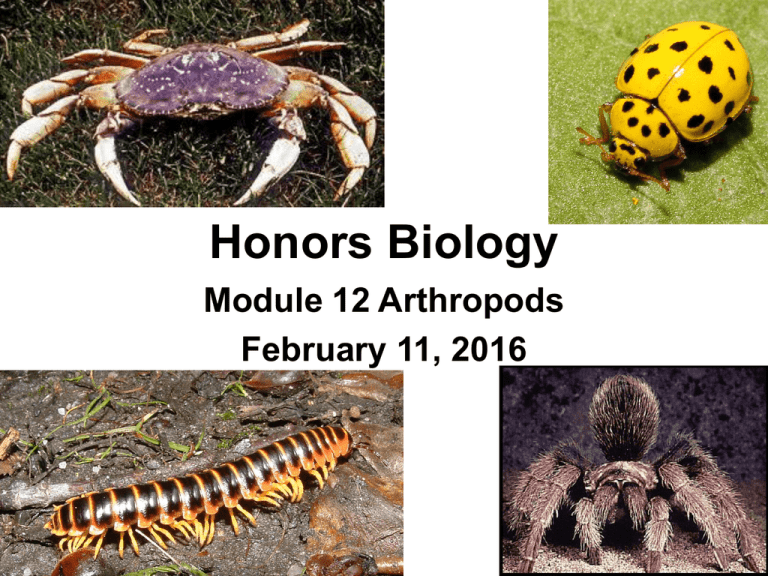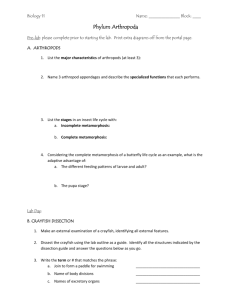Honors Biology - WordPress.com
advertisement

Honors Biology Module 12 Arthropods February 11, 2016 Class Challenge Next Week’s Class Challenge Valentine’s Day: Pay it forward • • • • • • • • • Give Valentine cards anonymously Volunteer at a local charity Visit the elderly Hug or call a family member Thank a teacher or student Shovel snow for a neighbor Leave treats in the yard for rabbits, squirrels and birds Donate soda tabs or cans to a local organization Make nutritional treats for dogs and cats of neighbors, friends or animal shelter • Volunteer to baby sit (for free) • Donate blood My Mistake on the Homework Assignment Begin Reading Module 12 Finish OYO for Module 11 Finish Study Guide for Module 11 Take Module 11 Test Missing Assignments Please see me at the end of class. Earthworm: Internal Anatomy Quiz • Earthworm Diagram External Anatomy of Earthworm A. B. C. D. E. Anus Segment Setae Clitellum Mouth Total 5 points Internal Anatomy of Earthworm 1. 2. 3. 4. 5. 6. 7. 8. 9. 10. Pharynx Aortic Arches Seminal Vesicle Crop Dorsal blood vessel Intestine Gizzard Ventral blood vessel Seminal receptacles Mouth 10 points Total 15 points Phylum Arthropoda Not having a backbone isn't as bad as it seems for some creatures. In fact, more than 95% of the world's animal population is spineless! They crawl on the ground, fly in the air and skim across the water. They also have an amazing effect on the environment 1. Help plants reproduce by carrying pollen from one plant to another. 2. They produce useful items such as silk, wax, honey, and drugs. Some anthropods are very necessary for the earth’s ecosystem, they can also be very dangerous. 1. Transmit deadly diseases. 2. They can destroy millions of acres of crops. Phylum Arthropoda 1. 2. 3. 4. 5. Crayfish Lobsters Spiders Scorpions Insects Arthropods have 5 Common Characteristics 1. All Arthropods have an Exoskelton Which is a body covering that typically is made of chitin, that provides support and protection. As the animal grows, it must molt or shed an old outer covering so that it can be replaced with a new one. 2. Body Segmentation The body is divided into three major divisions: 1. Head 2. Thorax- region between the head and abdomen. 3. Abdomen- region posterior to the thorax Some arthropods have the thorax and head united in a single segment called a cephalothorax This segmentation is necessary in order to allow the exoskeleton to shift with the movements of the body. Think of it like “joints” in the “armor” 3. Jointed Appendages Arthropoda means “joint-footed”. Their appendages are jointed. Their muscles form under the exoskelton, moving the joints from underneath. 4. A Ventral Nervous System Two ganglia form a brain (remember the earthworm), but it is more complex. The ventral nerve cord runs from the ganglia along the underside of the body to provide maximum protection from the exoskeleton and the bulk to the body. Arthropods do everything they can to protect the underside of their body protecting the ventral nerve cord. The Nervous System Is fed information through sensory organs. Antennae in the head region provide touch, taste, and smell sensations to the nervous system. All Arthropods have Eyes Compound eye: an eye made of many lenses, each with a very limited scope Simple eye: an eye with only one lens See figure 12.1 5. An Open Circulatory System Arthropods have quite an unusual circulatory system. In order to bring vital substances to every cell in the body, a heart in the dorsal (upper) region pumps blood into short vessels that empty out into different cavities of the body. This allows blood to flow right over all of the cells in that cavity. All Arthropods have Bilateral Symmetry Dissection of a Crayfish Crayfish Anatomy Part 1 http://youtu.be/2cBGuEDxvNo Crayfish Anatomy Part 2 http://youtu.be/wSGEt1mY2OM Shrimp Dissection Internal Anatomy of a Shrimp Crab Dissection Homework Read Module 12 pages 365 – 376; OYO questions: 12.1 – 12.5; Study Guide questions: define a-h, 2-11; Complete Lab book: Experiment 12.A Shrimp Dissection: Draw and Label external and internal anatomy; Quiz: External and Internal Anatomy of a shrimp; Class Challenge: Valentine’s Day: Pay it forward





